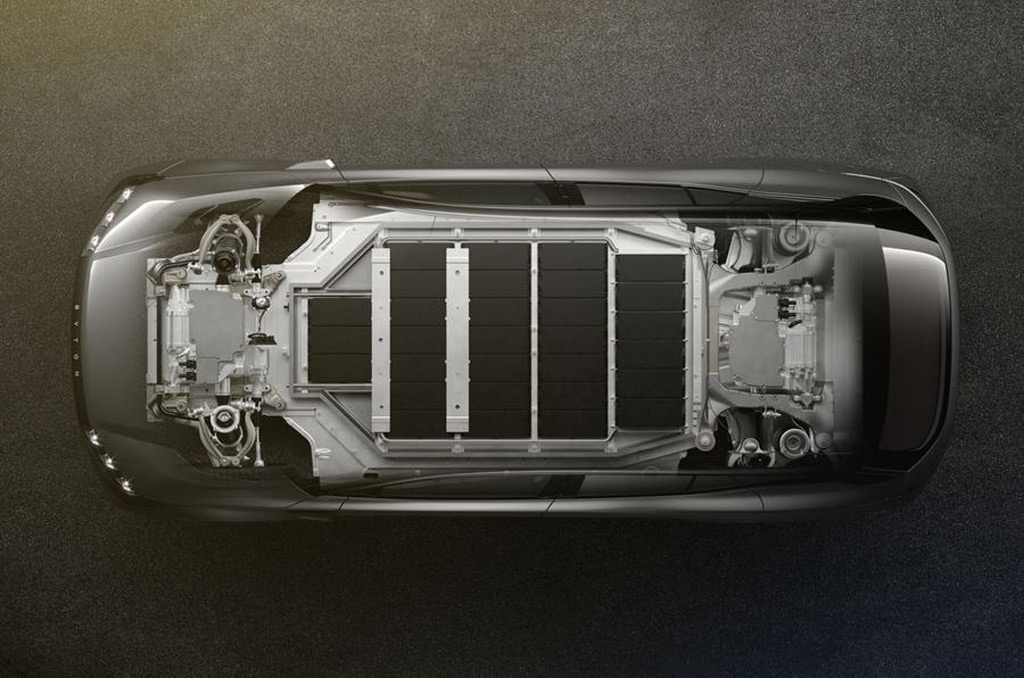Tesla vehicles have earned a reputation, boosted by YouTube reaction videos, for their blistering, dragstrip-worthy, straight-line acceleration. Porsche is getting into the electric performance game with even more fervor. The German luxury marque aims for the pedigree of Nürburgring times and track-ready handling with its upcoming 600-plus horsepower Taycan.
The Chinese-funded startup electric-car maker Byton, however, places performance bragging rights and sport-sedan pedigree low on its list of priorities. It has other targets in mind for its upcoming M-Byte crossover, due to go on sale in 2020, and K-Byte sedan that will arrive a year later. Both will be built on a completely new vehicle architecture with 71-kwh or 95-kwh battery packs, rear- or dual-motor drive configurations, and DC fast charging at about 150 kw.
“For Byton, we’re very clear this car is going to be a ride car, this is going to be a supremely comfortable car, a very, very quiet car,” said Byton’s chief engineer, David Twohig, with a smirk. “If you want to set a track record on Laguna Seca, go and buy another car.”
Playing the comfort card, with no qualms
He knows that’s going to raise eyebrows. “We’re not trying to market this thing as a sports car...we’re very focused on one item, which is a very comfortable car,” he told Motor Authority in an interview earlier this month at CES.
“It’s very easy to get an electric car to have impressive 0-60 times; it was interesting 10 years ago, it’s no longer interesting,” said Twohig, noting that electric cars cab even leave black lines on the tarmac.

Byton concept, 2018 Consumer Electronics Show
“The danger now is to say well, the thing accelerates like hell, therefore it’s a sports car, right? Wrong. And to say, well, to go around corners let’s stiffen the suspension up like hell. And I’ve now got a relatively heavy car with a very stiff suspension that accelerates like hell; but that isn’t a sports car.”
A false enthusiast market for EVs?
Twohig believes performance is a trap that some EV makers have fallen into, “And they’ve tried to kind of create this false enthusiast market,” he said.
Twohig says that without a focus on performance numbers, Byton's chassic engineers are free to tune the springs, dampers, and anti-roll bars, as well as the digital tuning of the chassis, to very clear targets. "We’re trying to think of everyone in the car, not just the guy or girl in the driver’s seat,” he said.
“That becomes even more important when the car is driving itself, and you are no longer the input, you’re simply receiving the acceleration outputs, be they longitudinal, vertical, or lateral. If the input is coming from the machine, all you get is the lateral acceleration. And it’s unpleasant.”

Byton concept, 2018 Consumer Electronics Show
Twohig, who joined the company last March, was formerly the chief engineer at Alpine and the head of vehicle engineering at Renault Sport, and is credited with creating the A110 roadster, a darling of the European auto-enthusiast press. He also led the engineering teams that developed the Renault Zoe and the first-generation Nissan Qashqai.
Connectivity and comfort for all
Although Twohig is a self-proclaimed driving enthusiast, he confesses that focusing on all the occupants, not just the driver is what makes the Byton model work. The company's philosophy is to produce a living room on wheels, with connectivity and comfort for all. “If you’re using the car day to day in downtown Shanghai—27 million occupants—I can tell you that an outright handling limit of 1g on dry tarmac is a little bit of an academic discussion,” Twohig mused.
Byton has partnered with Aurora, the same autonomous-drive technology company that works with Volkswagen and Hyundai, to provide what should eventually be Level 4 capability (conditional full self driving). But with that a few years away, at best, and Byton expected to allow a Level 2 system, somewhat like Tesla’s Autopilot, at launch, it’s angling for some other selling points.

Byton concept, 2018 Consumer Electronics Show
One of them will be a 48-inch-wide Shared Experience Display that spans the dashboard and has an advanced gesture control system that can be used not just by the driver but also by the passenger. Backseat passengers will get their own personalized screens, with voice control so advanced that it can detect Alexa-enabled commands from each voice individually. Also planned is a cloud-based Byton Life ecosystem that can keep track of everything from driver expressions to vitals, linking them to settings.
As the automaker explains on its site: “It is not about refining cars. It is about refining life. We will transform cars and traffic into places of well-being for you to make every single minute count, even on the move.”
The target price for both the M-Byte crossover and K-Byte sedan has been hinted to be about $45,000, or roughly half that of a well-equipped Tesla Model X or Model S and essentially in line with the Model 3.
At that price, comfort- and tech-minded shoppers should be willing to excuse the lack of a Ludicrous mode.
